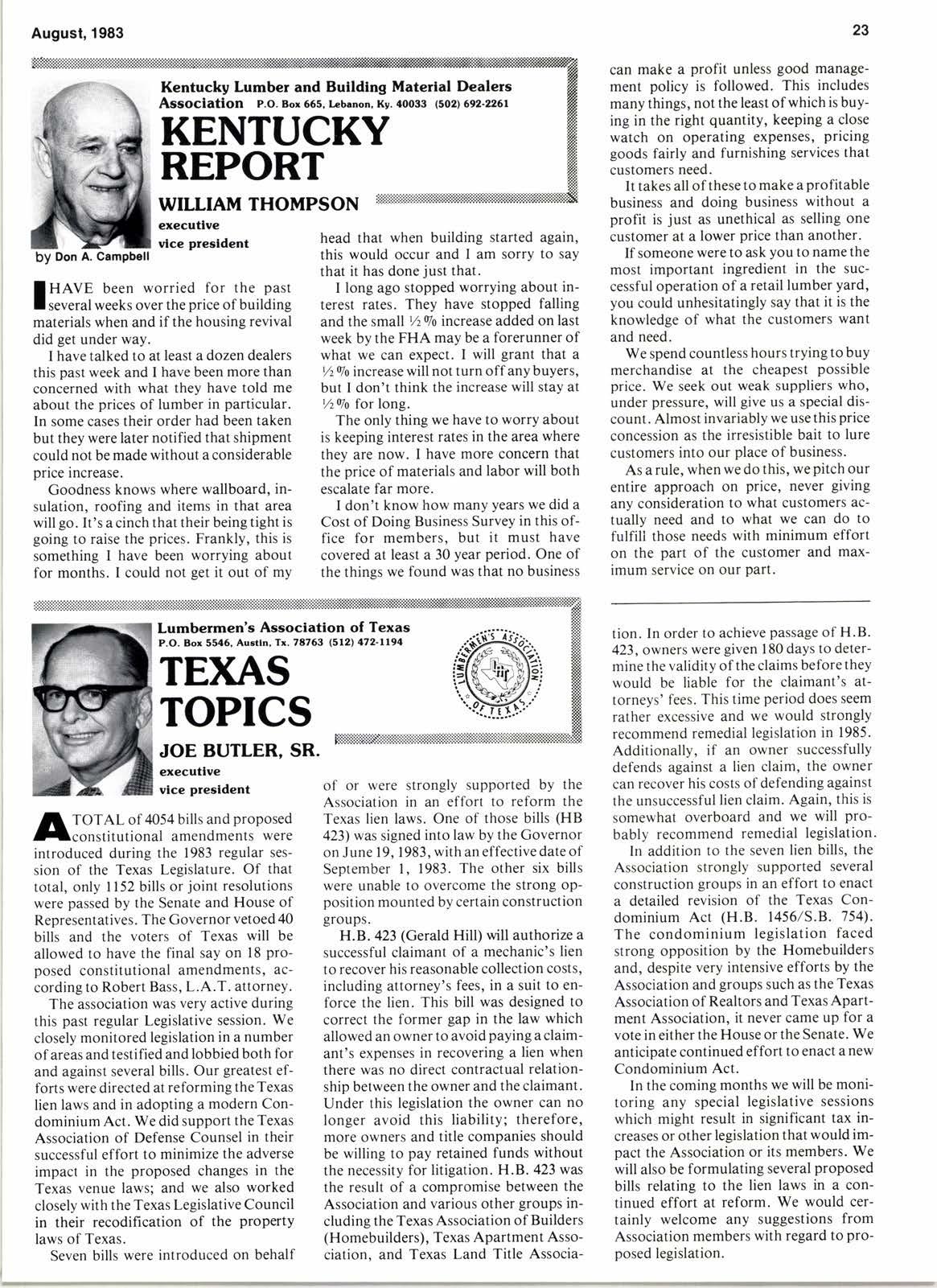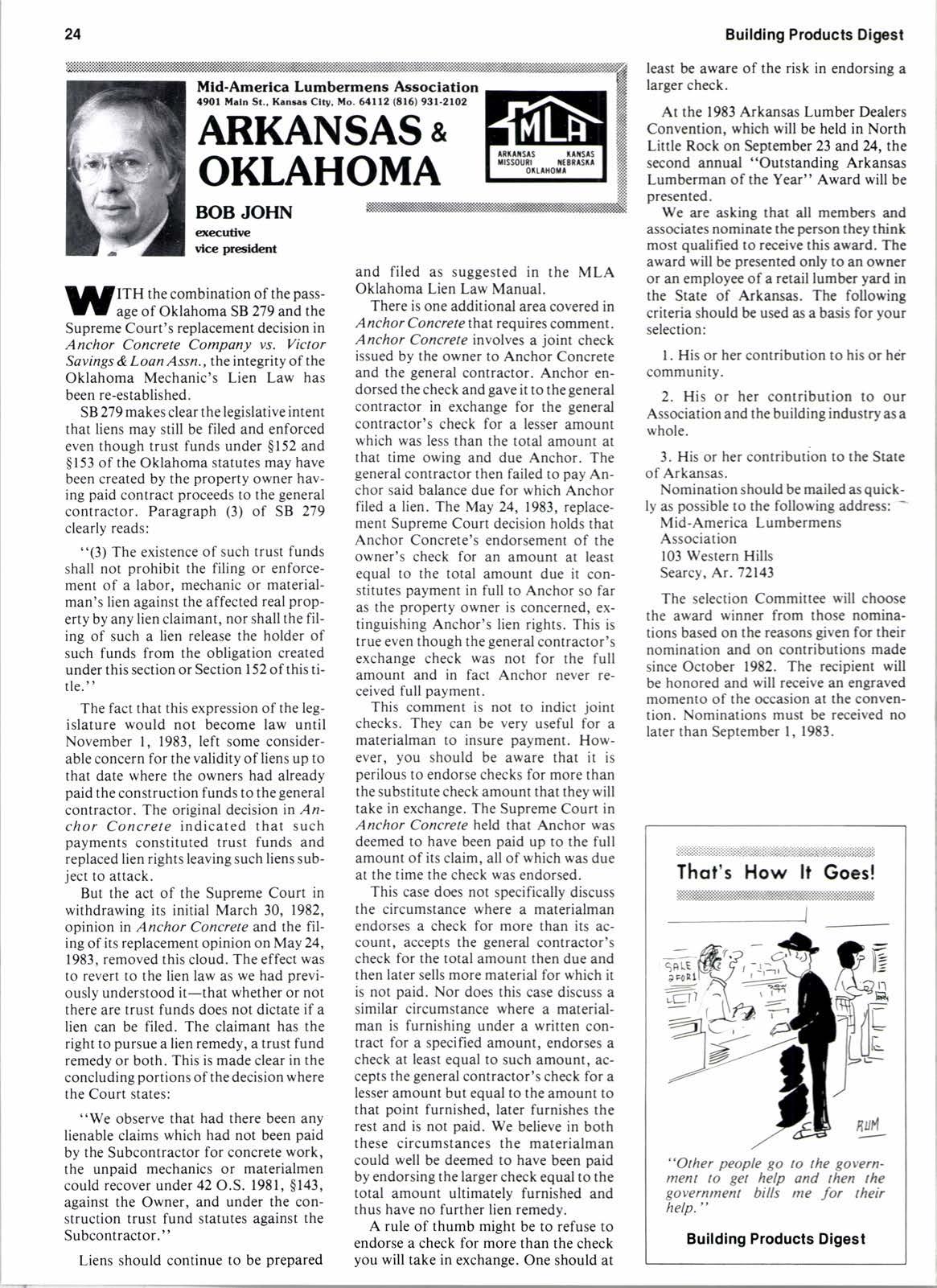
8 minute read
TEXAS TOPICS
JOE BUTLER, SR. executlve vlce presldent
A rornl of 4054 bills and proposed I66nslilutional amendments were introduced during the 1983 regular session of the Texas Legislature. Of that total, only ll52 bills or joint resolutions were passed by the Senate and House of Representatives. The Governor vetoed 40 bills and the voters of Texas will be allowed to have the final say on 18 proposed constitutional amendments, according to Robert Bass, L.A.T. attorney.
The association was very active during this past regular Legislative session. We closely monitored legislation in a number ofareas and testified and lobbied both for and against several bills. Our greatest efforts were directed at reforming the Texas lien laws and in adopting a modern Condominium Act. We did support the Texas Association of Defense Counsel in their successful effort to minimize the adverse impact in the proposed changes in the Texas venue laws; and we also worked closely with the Texas Legislative Council in their recodihcation of the property laws of Texas.
Seven bills were introduced on behalf head that when building started again, this would occur and I am sorry to say that it has done just that.
I long ago stopped worrying about interest rates. They have stopped falling and the small Yztlo increase added on last week by the FHA may be a forerunner of what we can expect. I will grant that a % 9o increase will not turn off any buyers, but I don't think the increase will stay at lzVo for long.
The only thing we have to worry about is keeping interest rates in the area where they are now. I have more concern that the price of materials and labor will both escalate far more.
I don't know how many years we did a Cost of Doing Business Survey in this office for members, but it must have covered at least a 30 year period. One of the things we found was that no business can make a profit unless good management policy is followed. This includes many things, not the least of which is buying in the right quantity, keeping a close watch on operating expenses, pricing goods fairly and furnishing services that customers need. of or were strongly supported by the Association in an effort to reform the Texas lien laws. One of those bills (HB 423) was signed into law by the Governor on June 19, 1983, with an effective date of September l, 1983. The other six bills were unable to overcome the strong opposition mounted by certain construction groups.
It takes all of these to make a profitable business and doing business without a profit is just as unethical as selling one customer at a lower price than another.
If someone were to ask you to name the most important ingredient in the successful operation of a retail lumber yard, you could unhesitatingly say that it is the knowledge of what the customers want and need.
We spend countless hours trying to buy merchandise at the cheapest possible price. We seek out weak suppliers who, under pressure, will give us a special discount. Almost invariably we use this price concession as the irresistible bait to lure customers into our place of business.
As a rule, when we do this, we Pitch our entire approach on price, never giving any consideration to what customers actually need and to what we can do to fulfili those needs with minimum effort on the part of the customer and maximum service on our part.
H.8.423 (Gerald Hill) win authorize a successful claimant of a mechanic's lien to recover his reasonable collection costs, including attorney's fees, in a suit to enforce the lien. This bill was designed to correct the former gap in the law which allowed an owner to avoid paying a claimant's expenses in recovering a lien when there was no direct contractual relationship between the owner and the claimant. Under this legislation the owner can no longer avoid this liability; therefore, more owners and title companies should be willing to pay retained funds without the necessity for litigation. H.B.423 was the result of a compromise between the Association and various other groups including the Texas Association of Builders (Homebuilders), Texas Apartment Association. and Texas Land Title Associa- tion. In order to achieve passage of H.B. 423, owners were given I 80 days to determine the validity of the claims before they would be liable for the claimant's attorneys' fees. This time period does seem rather excessive and we would strongly recommend remedial legislation in 1985. Additionally, if an owner successfully defends against a lien claim, the owner can recover his costs of defending against the unsuccessful lien claim. Again, this is somewhat overboard and we will probably recommend remedial legislation.
In addition to the seven lien bills, the Association strongly supported several construction groups in an effort to enact a detailed revision of the Texas Condominium Act (H.8. 1456/5.8. 754\. The condominium legislation faced strong opposition by the Homebuilders and, despite very intensive efforts by the Association and groups such as the Texas Association of Realtors and Texas Apartment Association, it never came up for a vote in either the House or the Senate. We anticipate continued effort to enact a new Condominium Act.
In the coming months we will be monitoring any special legislative sessions which might result in significant tax increases or other legislation that would impact the Association or its members. We will also be formulating several proposed bills relating to the lien laws in a continued effort at reform. We would certainly welcome any suggestions from Association members with regard to proposed legislation.
BOB JOHN €xecutltP rdce prestdent
ITH the combination of the passage of Oklahoma SB 279 and the Supreme Court's replacement decision in Anchor Concrete Company vs. Victor Savings & Loon Assn., the integrity of the Oklahoma Mechanic's Lien Law has been re-established.
SB 279 makes clear the legislative intent that liens may still be filed and enforced even though trust funds under $152 and $153 of the Oklahoma statutes may have been created by the property owner having paid contract proceeds to the general contractor. Paragraph (3) of SB 279 clearly reads:
"(3) The existence of such trust funds shall not prohibit the filing or enforcement of a labor, mechanic or materialman's lien against the affected real property by any lien claimant, nor shall the filing of such a lien release the holder of such funds from the obligation created under this section or Section 152 ofthis title. "
The fact that this expression of the legislature would not become law until November l, 1983, left some considerable concern for the validity of liens up to that date where the owners had already paid the construction funds to the general contractor. The original decision in .4nchor Concrere indicated that such payments constituted trust funds and replaced lien rights leaving such liens subject to attack.
But the act of the Supreme Court in withdrawing its initial March 30, 1982, opinion in Anchor Concrete and the filing of its replacement opinion on May 24, 1983, removed this cloud. The effect was to revert to the lien law as we had previously understood it-that whether or not there are trust funds does not dictate if a lien can be filed. The claimant has the right to pursue a lien remedy, a trust fund remedy or both. This is made clear in the concluding portions of the decision where the Court states:
"We observe that had there been any lienable claims which had not been paid by the Subcontractor for concrete work, the unpaid mechanics or materialmen could recover under 42 O.S. 1981, $143, against the Owner, and under the construction trust fund statutes against the Subcontractor. " and filed as suggested in the MLA Oklahoma Lien Law Manual.

There is one additional area covered in Anchor Concrete that requires comment. Anchor Concrete involves a joint check issued by the owner to Anchor Concrete and the general contractor. Anchor endorsed the check and gave it to the general contractor in exchange for the general contractor's check for a lesser amount which was less than the total amount at that time owing and due Anchor. The general contractor then failed to pay Anchor said balance due for which Anchor filed a lien. The May 24, 1983, replacement Supreme Court decision holds that Anchor Concrete's endorsement of the owner's check for an amount at least equal to the total amount due it constitutes payment in full to Anchor so far as the property owner is concerned, extinguishing Anchor's lien rights. This is true even though the general contractor's exchange check was not for the full amount and in fact Anchor never received full payment.
This comment is not to indict joint checks. They can be very useful for a materialman to insure payment. However, you should be aware that it is perilous to endorse checks for more than the substitute check amount that they will take in exchange. The Supreme Court in Anchor Concrete held that Anchor was deemed to have been paid up to the full amount of its claim. all of which was due at the time the check was endorsed.
This case does not specifically discuss the circumstance where a materialman endorses a check for more than its account, accepts the general contractor's check for the total amount then due and then later sells more material for which it is not paid. Nor does this case discuss a similar circumstance where a materialman is furnishing under a written contract for a specified amount, endorses a check at least equal to such amount, accepts the general contractor's check for a lesser amount but equal to the amount to that point furnished, later furnishes the rest and is not paid. We believe in both these circumstances the materialman could well be deemed to have been paid by endorsing the larger check equal to the total amount ultimately furnished and thus have no further lien remedy.
A rule of thumb might be to refuse to endorse a check for more than the check you will take in exchange. One should at least be awlue of the risk in endorsing a larger check.
At the l9E3 Arkansas Lumber Dealers Convention, which will be held in North Little Rock on September 23 and%, the second annual "Outstanding Arkansas Lumberman of the Year" Award will be presented.
We are asking that all members and ass@iates nominate the person they think most qualified to receive this award. The award will be presented only to an owner or an employee of a retail lumber yard in the State of Arkansas. The following criteria should be used as a basis for your selection: l. His or her contribution to his or hir community.
2. His or her contribution to our Association and the building industry as a whole.
3. His or her contribution to the State of Arkansas.
Nomination should be mailed as quickly as possible to the following address: -
Mid-America Lumbermens Association
103 Western Hills Searcy, Ar.72143
The selection Committee will choose the award winner from those nominations based on the reasons given for their nomination and on contributions made since October 1982. The recipient will be honored and will receive an engraved momento of the occasion at the convention. Nominations must be received no later than September I, 1983.
Thol's How lt Gocs!
"Other people go to the government Io get help and then the govern,nent bills me for their help. "










